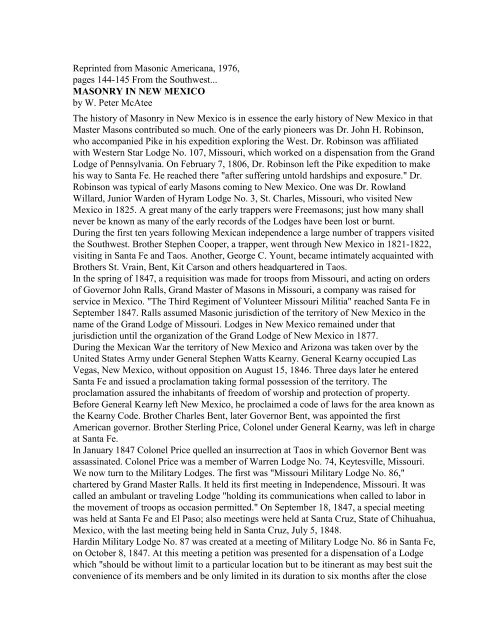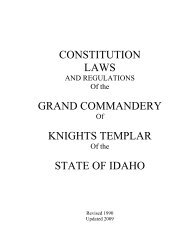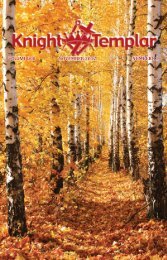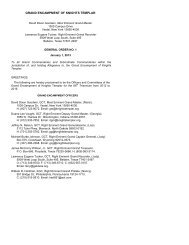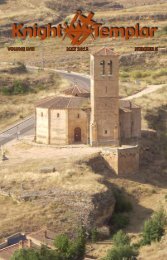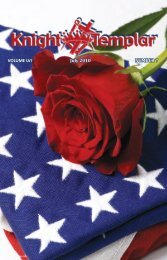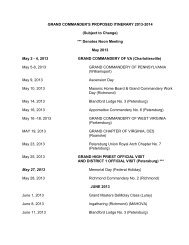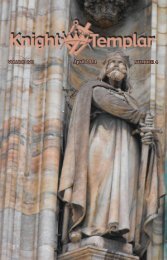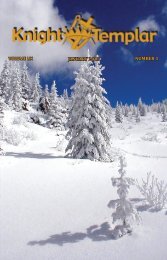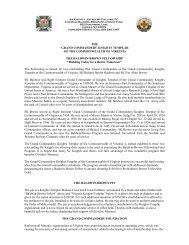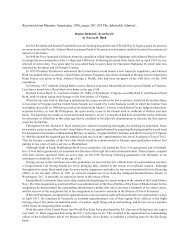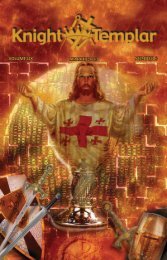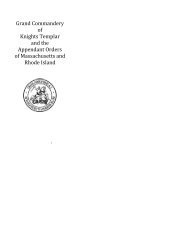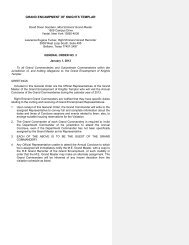masonry in new mexico - Grand Encampment of Knights Templar, USA
masonry in new mexico - Grand Encampment of Knights Templar, USA
masonry in new mexico - Grand Encampment of Knights Templar, USA
You also want an ePaper? Increase the reach of your titles
YUMPU automatically turns print PDFs into web optimized ePapers that Google loves.
Repr<strong>in</strong>ted from Masonic Americana, 1976,<br />
pages 144-145 From the Southwest...<br />
MASONRY IN NEW MEXICO<br />
by W. Peter McAtee<br />
The history <strong>of</strong> Masonry <strong>in</strong> New Mexico is <strong>in</strong> essence the early history <strong>of</strong> New Mexico <strong>in</strong> that<br />
Master Masons contributed so much. One <strong>of</strong> the early pioneers was Dr. John H. Rob<strong>in</strong>son,<br />
who accompanied Pike <strong>in</strong> his expedition explor<strong>in</strong>g the West. Dr. Rob<strong>in</strong>son was affiliated<br />
with Western Star Lodge No. 107, Missouri, which worked on a dispensation from the <strong>Grand</strong><br />
Lodge <strong>of</strong> Pennsylvania. On February 7, 1806, Dr. Rob<strong>in</strong>son left the Pike expedition to make<br />
his way to Santa Fe. He reached there "after suffer<strong>in</strong>g untold hardships and exposure." Dr.<br />
Rob<strong>in</strong>son was typical <strong>of</strong> early Masons com<strong>in</strong>g to New Mexico. One was Dr. Rowland<br />
Willard, Junior Warden <strong>of</strong> Hyram Lodge No. 3, St. Charles, Missouri, who visited New<br />
Mexico <strong>in</strong> 1825. A great many <strong>of</strong> the early trappers were Freemasons; just how many shall<br />
never be known as many <strong>of</strong> the early records <strong>of</strong> the Lodges have been lost or burnt.<br />
Dur<strong>in</strong>g the first ten years follow<strong>in</strong>g Mexican <strong>in</strong>dependence a large number <strong>of</strong> trappers visited<br />
the Southwest. Brother Stephen Cooper, a trapper, went through New Mexico <strong>in</strong> 1821-1822,<br />
visit<strong>in</strong>g <strong>in</strong> Santa Fe and Taos. Another, George C. Yount, became <strong>in</strong>timately acqua<strong>in</strong>ted with<br />
Brothers St. Vra<strong>in</strong>, Bent, Kit Carson and others headquartered <strong>in</strong> Taos.<br />
In the spr<strong>in</strong>g <strong>of</strong> 1847, a requisition was made for troops from Missouri, and act<strong>in</strong>g on orders<br />
<strong>of</strong> Governor John Ralls, <strong>Grand</strong> Master <strong>of</strong> Masons <strong>in</strong> Missouri, a company was raised for<br />
service <strong>in</strong> Mexico. "The Third Regiment <strong>of</strong> Volunteer Missouri Militia" reached Santa Fe <strong>in</strong><br />
September 1847. Ralls assumed Masonic jurisdiction <strong>of</strong> the territory <strong>of</strong> New Mexico <strong>in</strong> the<br />
name <strong>of</strong> the <strong>Grand</strong> Lodge <strong>of</strong> Missouri. Lodges <strong>in</strong> New Mexico rema<strong>in</strong>ed under that<br />
jurisdiction until the organization <strong>of</strong> the <strong>Grand</strong> Lodge <strong>of</strong> New Mexico <strong>in</strong> 1877.<br />
Dur<strong>in</strong>g the Mexican War the territory <strong>of</strong> New Mexico and Arizona was taken over by the<br />
United States Army under General Stephen Watts Kearny. General Kearny occupied Las<br />
Vegas, New Mexico, without opposition on August 15, 1846. Three days later he entered<br />
Santa Fe and issued a proclamation tak<strong>in</strong>g formal possession <strong>of</strong> the territory. The<br />
proclamation assured the <strong>in</strong>habitants <strong>of</strong> freedom <strong>of</strong> worship and protection <strong>of</strong> property.<br />
Before General Kearny left New Mexico, he proclaimed a code <strong>of</strong> laws for the area known as<br />
the Kearny Code. Brother Charles Bent, later Governor Bent, was appo<strong>in</strong>ted the first<br />
American governor. Brother Sterl<strong>in</strong>g Price, Colonel under General Kearny, was left <strong>in</strong> charge<br />
at Santa Fe.<br />
In January 1847 Colonel Price quelled an <strong>in</strong>surrection at Taos <strong>in</strong> which Governor Bent was<br />
assass<strong>in</strong>ated. Colonel Price was a member <strong>of</strong> Warren Lodge No. 74, Keytesville, Missouri.<br />
We now turn to the Military Lodges. The first was "Missouri Military Lodge No. 86,"<br />
chartered by <strong>Grand</strong> Master Ralls. It held its first meet<strong>in</strong>g <strong>in</strong> Independence, Missouri. It was<br />
called an ambulant or travel<strong>in</strong>g Lodge "hold<strong>in</strong>g its communications when called to labor <strong>in</strong><br />
the movement <strong>of</strong> troops as occasion permitted." On September 18, 1847, a special meet<strong>in</strong>g<br />
was held at Santa Fe and El Paso; also meet<strong>in</strong>gs were held at Santa Cruz, State <strong>of</strong> Chihuahua,<br />
Mexico, with the last meet<strong>in</strong>g be<strong>in</strong>g held <strong>in</strong> Santa Cruz, July 5, 1848.<br />
Hard<strong>in</strong> Military Lodge No. 87 was created at a meet<strong>in</strong>g <strong>of</strong> Military Lodge No. 86 <strong>in</strong> Santa Fe,<br />
on October 8, 1847. At this meet<strong>in</strong>g a petition was presented for a dispensation <strong>of</strong> a Lodge<br />
which "should be without limit to a particular location but to be it<strong>in</strong>erant as may best suit the<br />
convenience <strong>of</strong> its members and be only limited <strong>in</strong> its duration to six months after the close
<strong>of</strong> the Mexican War." This Lodge apparently was attached to First Regiment <strong>of</strong> Ill<strong>in</strong>ois Fort<br />
Volunteers. The record shows Military Lodge No. 87 had its meet<strong>in</strong>g <strong>in</strong> Albuquerque, Santa<br />
Fe, and Las Vegas, New Mexico. All records <strong>of</strong> the Hard<strong>in</strong> Military Lodge have been lost.<br />
Next are the two Lodges at Fort Union. Military forts were established throughout New<br />
Mexico by the American Army for protection aga<strong>in</strong>st Indians. The first <strong>of</strong> these was Fort<br />
Marcy <strong>in</strong> Santa Fe. Next was Fort Union, which became the headquarters <strong>of</strong> the N<strong>in</strong>th<br />
Military Department.<br />
Fort Union is important to the history <strong>of</strong> Free<strong>masonry</strong> <strong>in</strong> the Southwest because it was here<br />
that Chapman and Union Lodges were established. Chapman Lodge was first organized as<br />
Missouri Lodge No. 95 and Union Lodge as Missouri Lodge No. 480. The first<br />
communication <strong>of</strong> Chapman Lodge was held March 28, 1862. On May 24, 1867, for military<br />
reasons, the Lodges were requested to move outside <strong>of</strong> the Government reservation, the last<br />
meet<strong>in</strong>g at the Fort be<strong>in</strong>g held on July 27, 1867. Thereafter, Chapman Lodge was<br />
permanently established <strong>in</strong> Las Vegas. It was one <strong>of</strong> the four Lodges <strong>in</strong>strumental <strong>in</strong><br />
organiz<strong>in</strong>g the <strong>Grand</strong> Lodge <strong>of</strong> New Mexico <strong>in</strong> August 1877 and was chartered as Chapman<br />
Lodge No. 2.<br />
For several years the Masons at Fort Union were without a Lodge and presumably attended<br />
meet<strong>in</strong>gs at Chapman Lodge some 30 miles away. A petition to organize a <strong>new</strong> Lodge at the<br />
Fort was sought. Union Lodge received its dispensation on May 30, 1874, and was chartered<br />
on October 15, 1874. When Fort Union was abandoned, Union Lodge erected a hall at<br />
Watrous. Because the activity <strong>of</strong> the Lodge depended on members liv<strong>in</strong>g <strong>in</strong> Wagon Mound, it<br />
was decided to remove to that place where the first communication was held June 30, 1919.<br />
The first Mason to settle <strong>in</strong> New Mexico was Charles Bent. This extraord<strong>in</strong>ary man was born<br />
<strong>in</strong> what is now West Virg<strong>in</strong>ia. He had a good education, some military tra<strong>in</strong><strong>in</strong>g, and some<br />
knowledge <strong>of</strong> medic<strong>in</strong>e. In 1828 Charles Bent and his associates established trad<strong>in</strong>g posts<br />
along the l<strong>in</strong>e extend<strong>in</strong>g from the 100th meridian on the Arkansas River, along the river north<br />
to its source, to the 42nd parallel, and then west to the Pacific Ocean. The most important<br />
was Bent's Fort, completed <strong>in</strong> 1842, 650 miles west <strong>of</strong> Fort Leavenworth and to the west <strong>of</strong><br />
La Junta, Colorado. Bent established a system <strong>of</strong> safe trade between the United States and<br />
Mexico. He was a member <strong>of</strong> Missouri Lodge No. 1, St. Louis.<br />
Another dist<strong>in</strong>guished pioneer Freemason was Dr. David Waldo, also a member <strong>of</strong> Missouri<br />
No. 1. Dr. Waldo engaged <strong>in</strong> the fur trade with a store <strong>in</strong> Taos. He was an uncle <strong>of</strong> Henry L.<br />
Waldo, later Chief Justice <strong>of</strong> the territory <strong>of</strong> New Mexico and <strong>Grand</strong> Master <strong>of</strong> the Masons <strong>in</strong><br />
New Mexico <strong>in</strong> 1878. In 1869 when Bent Lodge No. 204 was chartered by the <strong>Grand</strong> Lodge<br />
<strong>of</strong> Missouri, Dr. Waldo deeded the site for the Lodge Hall.<br />
Repr<strong>in</strong>ted from Masonic Americana, 1,976, pages 14(i-141 From the Southwest...<br />
Cont<strong>in</strong>ued from April 2007, pages 16-17<br />
Ceran St. Vra<strong>in</strong>, known as Colonel St. Vra<strong>in</strong>, came to New Mexico about 1830 and became<br />
one <strong>of</strong> the most highly respected and <strong>in</strong>fluential citizens <strong>in</strong> the state. He was possessed with<br />
good education, f<strong>in</strong>e natural abilities, highest style <strong>of</strong> courtesy, and very good energy <strong>in</strong><br />
enterprise. He engaged <strong>in</strong> merchandis<strong>in</strong>g and manufactur<strong>in</strong>g. His upright deal<strong>in</strong>gs and<br />
fairness and courteous treatment <strong>of</strong> any whom he came <strong>in</strong> contact with won him a host <strong>of</strong><br />
friends.<br />
St. Vra<strong>in</strong> was raised <strong>in</strong> Montezuma Lodge No. 109 on January 25, 1855, and demitted <strong>in</strong>
1860. It was probably he that procured a warrant from the <strong>Grand</strong> Master <strong>of</strong> the <strong>Grand</strong> Lodge<br />
<strong>of</strong> Missouri to constitute Bent Lodge No. 204, Taos, August 4, 1860, <strong>of</strong> which he was<br />
Treasurer and Christopher Carson was Junior Warden. When the Civil War broke out, St.<br />
Vra<strong>in</strong> helped organize the first New Mexico Calvary and became its Colonel with Kit Carson<br />
as Lt. Colonel. After the end <strong>of</strong> the Civil War, St. Vra<strong>in</strong> moved to Mora, near Fort Union,<br />
then a pr<strong>in</strong>cipal military base <strong>in</strong> the Southwest. He died there October 28, 1870, and was<br />
buried with Masonic services.<br />
Christopher "Kit" Carson was raised <strong>in</strong> Montezuma Lodge No. 109, December 26, 1854.<br />
When Bent Lodge No.204 was chartered, Carson demitted and became its first Junior<br />
Warden. Carson was born <strong>in</strong> Kentucky, December 24, 1809. At the age <strong>of</strong> 15, he was<br />
apprenticed to a saddler but ran away from home and jo<strong>in</strong>ed a party <strong>of</strong> hunters <strong>in</strong> Santa Fe,<br />
New Mexico. In 1851 Kit decided to settle down and become a rancher. He and Lucien<br />
Maxwell established a settlement on the Raydo, 50 miles east <strong>of</strong> Taos, to raise hay and gra<strong>in</strong><br />
for Fort Union.<br />
Brother Carson was appo<strong>in</strong>ted Indian agent because <strong>of</strong> his long experience <strong>in</strong> deal<strong>in</strong>g with the<br />
Indians. When the Civil War came, his services were welcomed by the government and to<br />
him fell the command <strong>of</strong> the New Mexico regiment as Colonel. In 1865 he was breveted<br />
Brigadier General for his achievements.<br />
Other pioneers <strong>in</strong>clude Ferd<strong>in</strong>and Maxwell, the merchant pr<strong>in</strong>ce <strong>of</strong> the trail; Jacob Houghton,<br />
New Mexico's first Chief Justice under the American rule; Kirby Benedict, Chief Justice<br />
from 1858-1866. As the first Masonic Lodge chartered after the Territory <strong>of</strong> New Mexico<br />
was organized under the United States, Montezuma Lodge represented the <strong>Grand</strong> Lodge <strong>in</strong><br />
sponsor<strong>in</strong>g other Lodges and aid<strong>in</strong>g <strong>in</strong> their organization. At this time the Territory <strong>of</strong> New<br />
Mexico <strong>in</strong>cluded the present area <strong>of</strong> Arizona. The District Deputy <strong>Grand</strong> Master was Joab<br />
Houghton, Master <strong>of</strong> Montezuma Lodge, 1855-1856.<br />
New Mexico, <strong>in</strong> effect, jo<strong>in</strong>ed hands with the Union dur<strong>in</strong>g the Civil War. Confederates<br />
occupied the Territory <strong>in</strong> an effort to form an alliance with Utah <strong>in</strong> the hope <strong>of</strong> the conquest<br />
<strong>of</strong> California. The South needed the gold which came from California and a safe route to<br />
transport it. John R. Baylor and 600 Confederates took Fort Bliss and proceeded up the valley<br />
toward Santa Fe. On August 1, 1861, Baylor proclaimed all <strong>of</strong> New Mexico south <strong>of</strong> the 34th<br />
parallel as the <strong>new</strong> Territory <strong>of</strong> Arizona. He proclaimed himself temporary Governor. The<br />
battle which returned all <strong>of</strong> New Mexico to the Union was at Glorieta Pass on March 28, 1862.<br />
New Mexico became the last frontier and a refuge for lawless elements. A <strong>new</strong> group <strong>of</strong><br />
restless cattlemen from western Texas drifted <strong>in</strong>to the Territory. Colfax County became a<br />
favorite retreat for the crim<strong>in</strong>al element mov<strong>in</strong>g <strong>in</strong> from the Colorado region, ahead <strong>of</strong> the<br />
railroad. Outlaws ranged the pla<strong>in</strong>s and mounta<strong>in</strong>s; attack<strong>in</strong>g travelers, stage coaches, and<br />
wagon tra<strong>in</strong>s.<br />
In 1879, after many difficulties and delays, railroads f<strong>in</strong>ally reached New Mexico, converg<strong>in</strong>g<br />
from three directions: the Southern Pacific from the Pacific Coast; the Texas & Pacific from<br />
the southwest; the Atchison-Topeka & Santa Fe from the Missouri River. The first passenger<br />
tra<strong>in</strong> entered the Territory at Otero, February 11, 1879.<br />
An <strong>in</strong>terest<strong>in</strong>g event occurred <strong>in</strong> the life <strong>of</strong> Brother John Lemon, a prom<strong>in</strong>ent leader <strong>in</strong> his<br />
lifetime. He was captured by the Confederates at Mesilla. They escorted him to a nearby tree,<br />
to hang him. He made the <strong>Grand</strong> Hail<strong>in</strong>g Sign <strong>of</strong> Distress, whereupon the Confederates, after<br />
a short conference, spared his life. At this time, a German named Applezoller was with
Lemon, and realiz<strong>in</strong>g that he was about to lose his life, he excitedly made some signs<br />
exclaim<strong>in</strong>g he belonged to the same Lodge. He was not believed and was hanged, but<br />
someone rushed <strong>in</strong> and cut the rope, sav<strong>in</strong>g his life.<br />
With the beg<strong>in</strong>n<strong>in</strong>g <strong>of</strong> the Spanish-American War, Masons from all over New Mexico<br />
responded to the call <strong>of</strong> their country. In 1898 when the call went out for volunteers for the<br />
Rough Riders to fight <strong>in</strong> the Spanish-American War, New Mexico men responded. After the<br />
successful completion <strong>of</strong> the war, the attention <strong>of</strong> New Mexicans was aga<strong>in</strong> directed to the<br />
long struggle for statehood. This 60 year effort was f<strong>in</strong>ally ended successfully when, on<br />
August 11, 1911, the Enabl<strong>in</strong>g Act was approved by Congress, and signed by President and<br />
Brother Taft. On January 6, 1912, New Mexico became the 47th state to jo<strong>in</strong> the Union.<br />
Statehood did not, <strong>of</strong> course, solve all <strong>of</strong> the problems <strong>of</strong> the area automatically. Troubles<br />
with Mexican bandits under Pancho Villa came <strong>in</strong> 1916, and members were called upon to<br />
participate <strong>in</strong> the Mexican Border Service.<br />
Many participated <strong>in</strong> World War I. Capta<strong>in</strong> Joe Quensenberry from Las Cruces was<br />
commended by General Persh<strong>in</strong>g for sett<strong>in</strong>g the esprit de corps for the American Army. He<br />
was the leader <strong>of</strong> the first American unit to capture German prisoners and a German mach<strong>in</strong>e<br />
gun.<br />
It is fitt<strong>in</strong>g for us to remember and honor the pioneer Masons <strong>of</strong> New Mexico.


